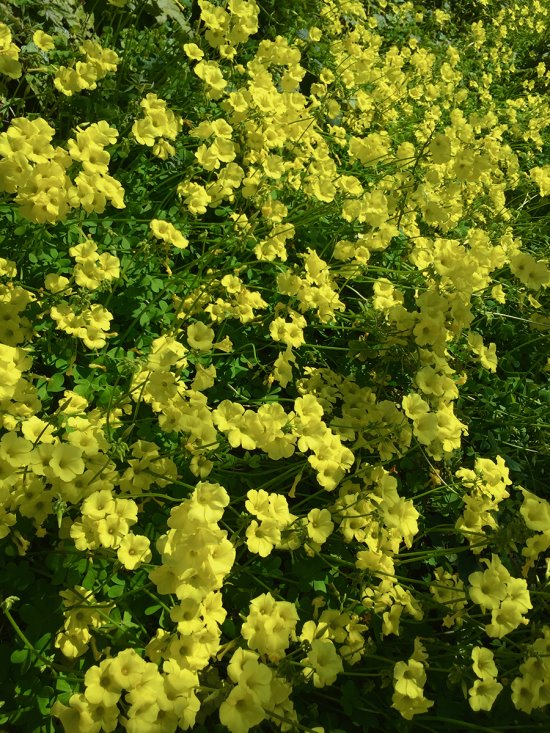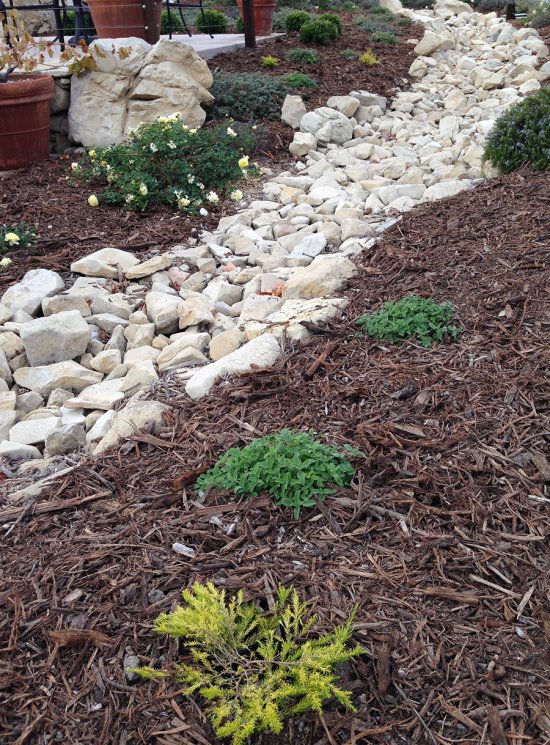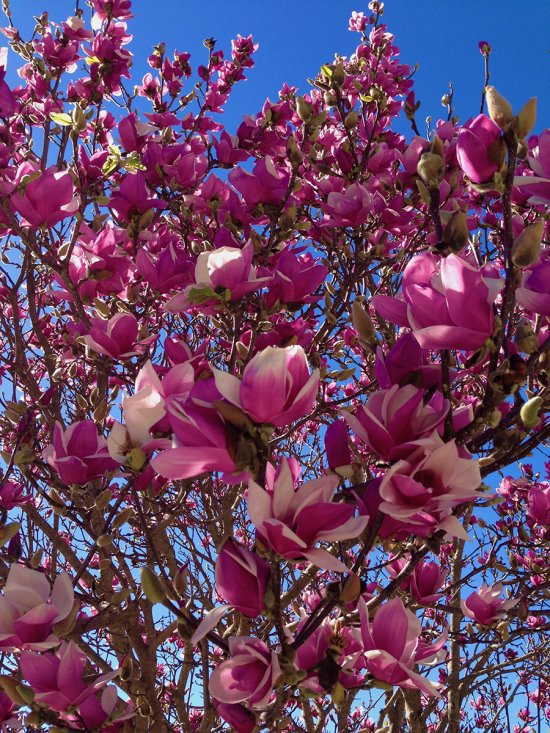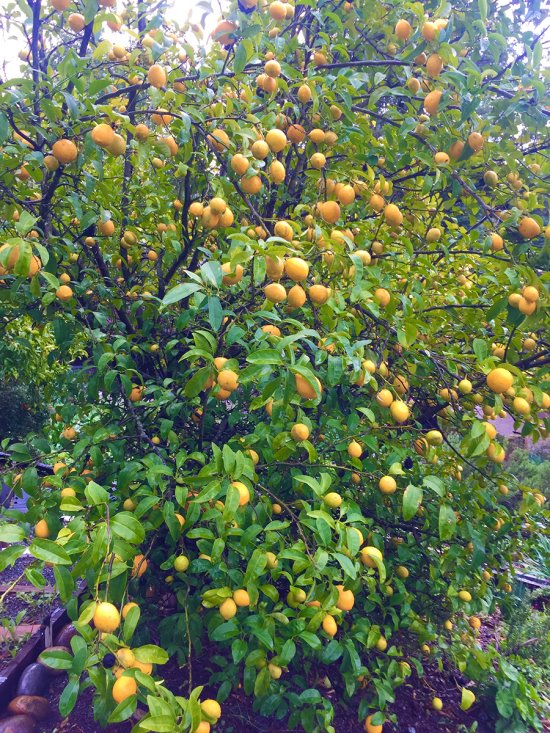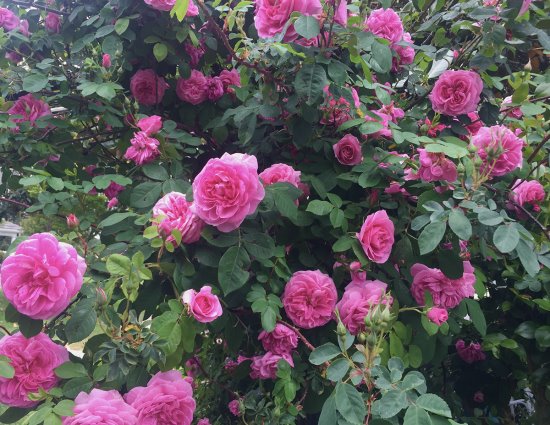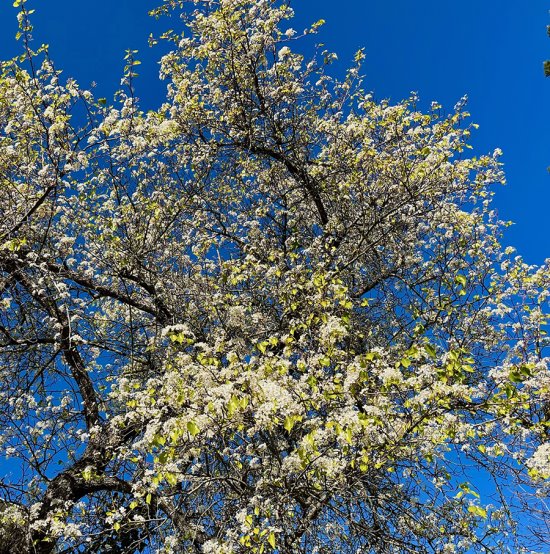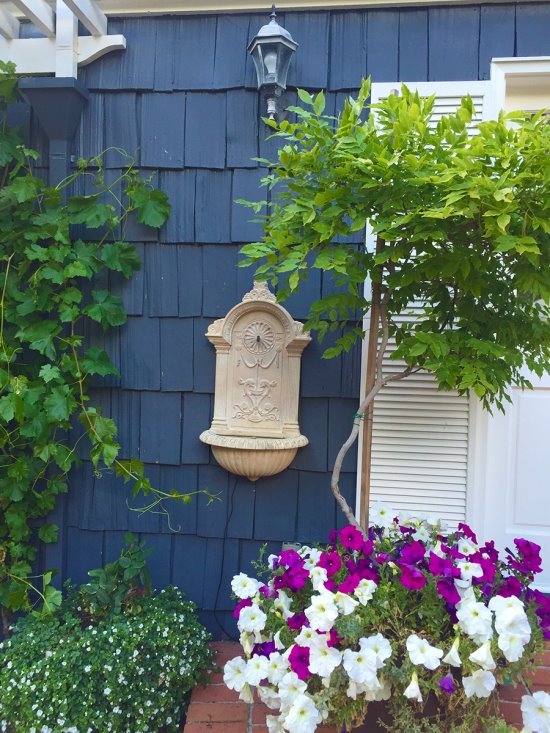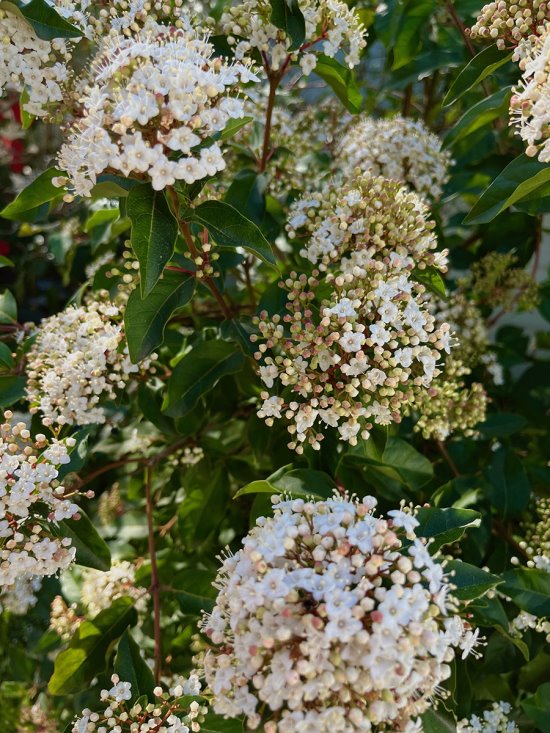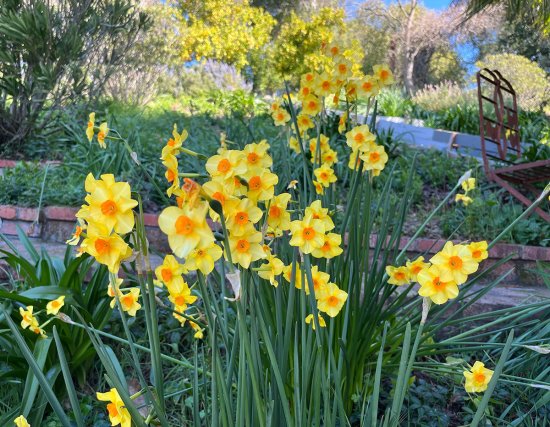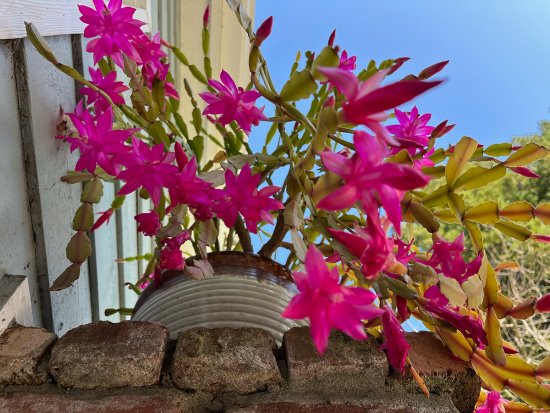 |
|
|
The fluorescent cerise blooms of the Christmas cactus. Photos Cynthia Brian
|
|
|
|
|
|
"No race can prosper till it learns that there is as much dignity in tilling a field as in writing a poem." ~ Booker T. Washington
 For the past two months, I've been working on writing a series of children's books, a bit of prose, a bit of poetry. But with the ubiquitous sunny days and warm temperatures, digging in my garden wins the race. In the past, February has notoriously been a drab and dreary month, but this year it is filled with fabulous flowers, unseasonal sunshine, and idyllic conditions for working outside. My Christmas cactus shines with fluorescent cerise blooms, the blazing blue of the rosemary bush host busy, buzzing bees, the viburnum is covered in masses of sweet-smelling white blossoms, and roses continue to bud and bloom. Wood sorrel or oxalis already showcases bursts of buttery yellow flowers. These shamrocks don't usually appear until St. Patrick's Day. The purple-tinted flowers of the marvelous magnolia liliiflora, known as the tulip magnolia, suggest that spring may have already sprung.
For the past two months, I've been working on writing a series of children's books, a bit of prose, a bit of poetry. But with the ubiquitous sunny days and warm temperatures, digging in my garden wins the race. In the past, February has notoriously been a drab and dreary month, but this year it is filled with fabulous flowers, unseasonal sunshine, and idyllic conditions for working outside. My Christmas cactus shines with fluorescent cerise blooms, the blazing blue of the rosemary bush host busy, buzzing bees, the viburnum is covered in masses of sweet-smelling white blossoms, and roses continue to bud and bloom. Wood sorrel or oxalis already showcases bursts of buttery yellow flowers. These shamrocks don't usually appear until St. Patrick's Day. The purple-tinted flowers of the marvelous magnolia liliiflora, known as the tulip magnolia, suggest that spring may have already sprung.
 It's mid-February and still no sign of rain. January was considered the driest month on record in California since 1895. Daffodils blanket the roadways and hillsides; ornamental pear trees are in full bloom with peach buds prepared to explode into luminous pink. Back in December when we experienced the atmospheric river and the record-breaking 17 feet of snowfall in the Sierras, we had high hopes that drought conditions may be receding.
It's mid-February and still no sign of rain. January was considered the driest month on record in California since 1895. Daffodils blanket the roadways and hillsides; ornamental pear trees are in full bloom with peach buds prepared to explode into luminous pink. Back in December when we experienced the atmospheric river and the record-breaking 17 feet of snowfall in the Sierras, we had high hopes that drought conditions may be receding.
 Here are some tasks to accomplish now.
Here are some tasks to accomplish now.
 - If you haven't already, it is time to turn on the sprinklers and give your garden a deep drink. Check the sprinkler heads on lawns as grass tends to grow over them when not in use during the winter months. If your irrigation system needs a tune-up, professionals have told me that winter is the ideal occasion to schedule appointments for repairs or installations. In the summer months, when we need to irrigate the most, specialists are swamped with emergencies.
- If you haven't already, it is time to turn on the sprinklers and give your garden a deep drink. Check the sprinkler heads on lawns as grass tends to grow over them when not in use during the winter months. If your irrigation system needs a tune-up, professionals have told me that winter is the ideal occasion to schedule appointments for repairs or installations. In the summer months, when we need to irrigate the most, specialists are swamped with emergencies.
 - Water in the morning to give plants the opportunity to dry out before night.
- Water in the morning to give plants the opportunity to dry out before night.
 - Fertilize trees, shrubs, and ground covers. When it comes to fertilizers, people often wonder what N, P, K mean. N stands for nitrogen which stimulates leaf formation to give plants the luminous, healthy green. P is phosphorus which encourages strong root formation, aids in flowering and fruit set. K is for potassium providing disease resistance and hardiness to plants. The three numbers that you see on labels such as 5-10-15 indicate the percentage of nitrogen, phosphorus, and potassium that the product contains. This listing is required by law on all packages of organic, synthetic, and chemical fertilizers. Keep in mind that although nitrogen, phosphorus, and potassium are necessary to maintain plant health, there are more than 20 other nutrients needed as well.
- Fertilize trees, shrubs, and ground covers. When it comes to fertilizers, people often wonder what N, P, K mean. N stands for nitrogen which stimulates leaf formation to give plants the luminous, healthy green. P is phosphorus which encourages strong root formation, aids in flowering and fruit set. K is for potassium providing disease resistance and hardiness to plants. The three numbers that you see on labels such as 5-10-15 indicate the percentage of nitrogen, phosphorus, and potassium that the product contains. This listing is required by law on all packages of organic, synthetic, and chemical fertilizers. Keep in mind that although nitrogen, phosphorus, and potassium are necessary to maintain plant health, there are more than 20 other nutrients needed as well.
 - Get a head-start on pulling weeds while they are small, and the ground is malleable. Weeds harbor disease.
- Get a head-start on pulling weeds while they are small, and the ground is malleable. Weeds harbor disease.
 - Apply snail bait around plants that are susceptible to snails and slugs.
- Apply snail bait around plants that are susceptible to snails and slugs.
 - Use an organic systemic insecticide around the base of roses to prevent the first flush of aphids.
- Use an organic systemic insecticide around the base of roses to prevent the first flush of aphids.
 - Spray fruit trees, roses, and citrus with dormant oil to protect them from overwintering insects and fungal diseases. Copper Sulfate is approved for organic use and offers a strong defense against fungal pathogens. Be sure to follow all safety and application instructions, as copper is a potent control method, and should be used responsibly. Do not spray on windy days. Wash any citrus before consuming. Harvest tangelos, lemons, oranges and limes as needed.
- Spray fruit trees, roses, and citrus with dormant oil to protect them from overwintering insects and fungal diseases. Copper Sulfate is approved for organic use and offers a strong defense against fungal pathogens. Be sure to follow all safety and application instructions, as copper is a potent control method, and should be used responsibly. Do not spray on windy days. Wash any citrus before consuming. Harvest tangelos, lemons, oranges and limes as needed.
 - Check for mole and gopher activity. These rodents do not take a winter hiatus. It's best to trap them before they reproduce.
- Check for mole and gopher activity. These rodents do not take a winter hiatus. It's best to trap them before they reproduce.
 - Complete pruning of roses, grapes and berry bushes.
- Complete pruning of roses, grapes and berry bushes.
 - Sanitize tools between use. Alcohol, bleach, or hydrogen peroxide solutions are recommended.
- Sanitize tools between use. Alcohol, bleach, or hydrogen peroxide solutions are recommended.
 - Cut small branches of peach or crabapple to force the blooms for an indoor arrangement.
- Cut small branches of peach or crabapple to force the blooms for an indoor arrangement.
 - Plan an edible garden. What vegetables and herbs do you love the most? Find out what varieties are best planted from seed (arugula for instance) and what plants are better purchased in six-packs, quarts, or gallons. (tomatoes, in my opinion).
- Plan an edible garden. What vegetables and herbs do you love the most? Find out what varieties are best planted from seed (arugula for instance) and what plants are better purchased in six-packs, quarts, or gallons. (tomatoes, in my opinion).
 - Dress your garden with fresh mulch or chipped bark to maintain moisture, control temperatures, and minimize weeds.
- Dress your garden with fresh mulch or chipped bark to maintain moisture, control temperatures, and minimize weeds.
 - Add a rock dry creek to an area with run-off.
- Add a rock dry creek to an area with run-off.
 - Peruse gardening books and seed catalogs for ideas on what you want to plant. This season I suspect that we will be sowing seeds earlier as the soil warms.
- Peruse gardening books and seed catalogs for ideas on what you want to plant. This season I suspect that we will be sowing seeds earlier as the soil warms.
 - Repot houseplants. Remove dead leaves, add fresh soil, give them a sunshine retreat outdoors for a few hours.
- Repot houseplants. Remove dead leaves, add fresh soil, give them a sunshine retreat outdoors for a few hours.
 - Enhance a corner of your exterior with a wall fountain and colorful potted plants.
- Enhance a corner of your exterior with a wall fountain and colorful potted plants.
 - Build a path or walkway that will integrate into the landscape and complement your home.
- Build a path or walkway that will integrate into the landscape and complement your home.
 - Get outside to soak up the Vitamin D. Garden, stroll in a park, hike a trail, or walk the reservoir. Pay attention to the natural landscape.
- Get outside to soak up the Vitamin D. Garden, stroll in a park, hike a trail, or walk the reservoir. Pay attention to the natural landscape.
 - Check out the FREE Seed Bank at Moraga Library. Free vegetable, herbs, flowers, and milkweed seeds are available thanks to the efforts of the Moraga Garden Club, the high school all-girl Scout Troop 401 and middle school Girl Scout Troop 33778. - www.moragagardenclub.com
- Check out the FREE Seed Bank at Moraga Library. Free vegetable, herbs, flowers, and milkweed seeds are available thanks to the efforts of the Moraga Garden Club, the high school all-girl Scout Troop 401 and middle school Girl Scout Troop 33778. - www.moragagardenclub.com
 Although California needs increased precipitation, and we must all continue to be diligent in conserving water, I admit that I am enjoying springtime in February immensely. The hills are currently green, cows are munching on the plentiful grass, the air smells fresh, and the creeks are trickling. A bit of the winter bite remains as soon as the sun sets, and the moon rises. It is a lovely time to be outside expressing gratitude for Mother Earth. There is indeed dignity in digging in the dirt, and of course, it is what I write about so that we will prosper and thrive through nature.
Although California needs increased precipitation, and we must all continue to be diligent in conserving water, I admit that I am enjoying springtime in February immensely. The hills are currently green, cows are munching on the plentiful grass, the air smells fresh, and the creeks are trickling. A bit of the winter bite remains as soon as the sun sets, and the moon rises. It is a lovely time to be outside expressing gratitude for Mother Earth. There is indeed dignity in digging in the dirt, and of course, it is what I write about so that we will prosper and thrive through nature.
 Happy Gardening. Happy Growing.
Happy Gardening. Happy Growing.
|
Cynthia Brian sits on a green hillside.
Cynthia Brian, The Goddess Gardener, is available for hire to help you
prepare for your spring garden. Raised in the vineyards of Napa County,
Cynthia is a New York Times best-selling author, actor, radio personality,
speaker, media and writing coach as well as the Founder and Executive
Director of Be the Star You Are!r 501 c3. Tune into Cynthia's StarStyler
Radio Broadcast at www.StarStyleRadio.com.
Buy copies of her books, including, Chicken Soup for the Gardener's Soul,
Growing with the Goddess Gardener, and Be the Star You Are!
www.cynthiabrian.com/online-store. Receive a FREE inspirational music DVD
and special savings.
Hire Cynthia for writing projects, garden consults, and inspirational
lectures.
Cynthia@GoddessGardener.com
www.GoddessGardener.com |

